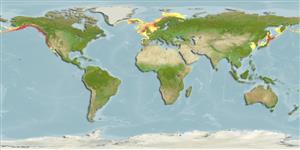Common names from other countries
Classification / Names / Names
ماع يماسا | فدارتم | Catalog of Fishes (gen., sp.) | ITIS | CoL | WoRMS
Environment: milieu / climate zone / depth range / distribution range
يسانش موب
; قمع تارييغت 0 - 60 m (Ref. 127878). Temperate
Pacific Ocean. Temperate to polar.
Length at first maturity / Size / Weight / نس
Maturity: Lm ? range ? - ? cm Max length : 32.5 cm TL يسنج صاوخ نودب / رن سنج; (Ref. 865)
Valves: Pure white; completely covered by what appears to be coarse maroon leather. Large white valves (Ref. 296).
Fisheries: The foot of the Gumboot Chiton is sometimes eaten in the same manner as the abalone (Ref. 296). Depth ranges from intertidal to 600 m. Inhabits a variety of bottom-types, but prefer stone and pebble (Ref. 290); at some periods in their life cycle, they teem into the intertidal zone (Ref. 339). Often found on the beach (Ref. 296).
Life cycle and mating behavior
غولب | لثم دیلوت | یزیر مخت | اه مخت | Fecundity | )ورال ( دازوت
Members of the class Polyplacophora are mostly gonochoric. Life cycle: Eggs hatch into lecitotrophic planktonic trocophore larvae (no veliger stage) which later metamorphose and settle on the bottom as young adults.
یلصا ذخآم
عجارم | هدننك گنهامه | ناراكمه
Burghardt, G. and L. Burghardt. 2006. (Ref. 296)
NCUI زمرق تسرهف رد تيعضو (Ref. 130435)
ستياس رظن زا تيعضو (Ref. 108899)
Not Evaluated
Not Evaluated
یناسنا هدافتسا
تاليش – يريگ يهام: هوقلاب هقالع
| FishSource |
اهرازبا
رتشيب تاعالطا
Age/Sizeدشرنزو - لوطلوط - لوطيسانش تخير)ورال ( دازوتيناوارف
يتنرتنيا عبانم
Estimates based on models
Preferred temperature
(Ref.
115969): 1.5 - 9.9, mean 6 (based on 341 cells).
یريذپ بيسآ
Low vulnerability (20 of 100).
تميق هقبط
Unknown.
